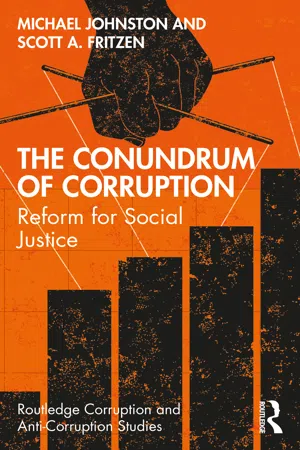IFighting the good fight
There was a time when most academic discussions of corruption began with a ritual acknowledgment to the effect that “not much research has been done on political and administrative corruption.” No one says that anymore. Over the past 30 years, corruption and reform – the latter also known, more recently, as “good governance” or “compliance” – has vaulted from obscurity to a place near the top of the international policy agenda. What was once the concern of a handful of scholars and activists has acquired a supporting structure of institutions – indeed, an anti-corruption industry – comprised of academic programs, non-governmental organizations (NGOs), laws and treaties, development aid programs, and the inevitable series of high-flown international conferences, frequently concluding with some sort of grand declaration.
Those developments drew much of their early energy from global political events (for a comprehensive history of anti-corruption efforts, see Kroeze et al., 2017). In 1986, for example, millions of Pinoys and Pinays took to the streets of Metro Manila to protest the electoral abuses, thievery, and outright violence of Ferdinand and Imelda Marcos. That “People Power” movement succeeded in ousting the president – a scenario repeated in 2001 with the resignation of Joseph Estrada and, in its own way, during Georgia’s “Rose Revolution” of 2003. The collapse of communist regimes in the Soviet Union and Eastern Europe both highlighted corruption as a systemic problem and seemed to make a compelling case for political and economic liberalization as a general prescription for human wellbeing. That outlook was congenial to powerful political and economic interests in the global North and West but became more debatable as the aftermath of democratic transitions proved problematical in many societies, and as those western societies began to look to their own corruption difficulties.
The launching of Transparency International (TI) in 1993 gave anti-corruption work visibility, common focus, and an international presence it had never had before. Before long it was joined by a number of other initiatives mounted by new or existing organizations. In the mid-1990s the Bretton Woods institutions joined the fight, as World Bank President James Wolfensohn launched an ambitious research and policy effort that continues to this day. Public and journalistic awareness was further heightened, beginning in 1995, by TI’s Corruption Perception Index (CPI), and in 1996 by the World Bank’s World Governance Indicators (WGI), which included an ambitious measure of control of corruption. Both of those early attempts to assess of the scope of corruption quickly drew criticism, but they have been joined by a wide range of other indicators. Whatever their strengths or shortcomings, the intensity of the debates over the scores countries received said much about the burgeoning interest in corruption and reform. At century’s end the Organization for Economic Cooperation and Development (OECD) hammered out its Anti-Bribery Convention, which entered into force in 1999. It was joined by other global and regional pacts, including the United Nations Convention Against Corruption (UNCAC) of 2005 that has been ratified by 140 signatories. National legislation regulating the international bribery activities of corporations began with the United States Foreign Corrupt Practices Act (FCPA), enacted in 1977 and subsequently amended to conform with the OECD Convention, but it was not until 2010 that the United Kingdom enacted its far-reaching Bribery Act. In 2017 France enacted legislation of its own, known as Sapin II (GAN Integrity (Business Anti-Corruption Portal), 2019; Georgetown University Law School, 2019).
Conundrum? What conundrum?
No one concerned with checking corruption assumed the job would be easy. But for a time, post-Cold War optimism, new support for reform from businesses and international organizations, innovative data and theories, and rapidly growing recognition of the harm corruption can do all suggested that significant accomplishments lay just over the horizon. Unfortunately, most such hopes have not materialized; while we still lack any precise data on the amounts or gravity of corruption in any country, much less around the world, few would argue we have decisively turned the tide.
It is not as though we have failed across the board. Just rescuing corruption issues from obscurity and making them prominent public concerns is a major accomplishment. There are societies, public institutions, and businesses that are well governed and well managed by any estimation, and some countries (e.g., Estonia, Georgia, Uruguay, Chile, Taiwan, Costa Rica) have made significant if uneven progress (Mungiu-Pippidi and Johnston, 2017). We know far more about the issue than we did 30 years ago, and we have a network of policies, organizations, and researchers on a scale, and level of sophistication, few could have imagined in those earlier days (indeed, ambitious and promising ideas for future corruption research can be found in Mungiu-Pippidi and Heywood, 2020).
Still, most reform efforts have met stiff headwinds (for evidence suggesting that most countries have made little or no progress against corruption over the past 20 years, see GFI (Global Financial Integrity), 2020). If anything, concern is mounting over surreptitious and offshore economic dealings, growing economic inequalities and their consequences for politics and government, “legal corruption” through which abuses of wealth and power enjoy the protection of the law, and the unsettling political impact of various “populist” politicians and parties. Many of the improving countries noted above are small and fairly homogenous societies; several have gone through deep crises that, while difficult in their own right, gave reformers special urgency and room to maneuver. Larger and more diverse societies, by contrast, have often proved resistant to reform. As TI says regarding its own 2018...
